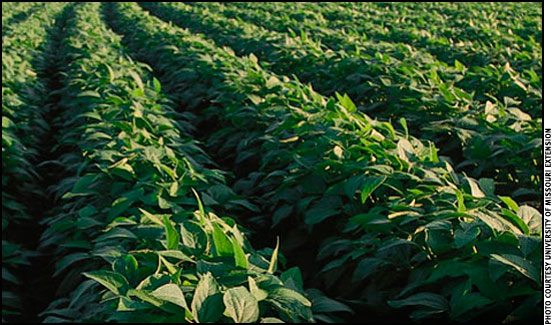
Lush Green Soybean Fields
May Not be Good Sign
University of Missouri specialist says nutrients are in leaf, not pod.
Farmers are reporting that in spite of prolonged drought and hot temperatures their soybean plants appear amazingly green for this time of year.
"Green soybean plants may not be a good sign," says a University of Missouri (MU) Extension soybean specialist, "even though the plants appear to be thriving, compared to the brown and dead cornstalks in adjoining fields.
"They may have adequate moisture," said Bill Wiebold, of the MU plant science division. "More than likely, the green results from high nitrogen levels in leaves that have not converted into protein stored in seed pods."
The plant requires a steady flow of water moving up the plant system from roots to leaves to pods, Wiebold explained in an MU teleconference.
"When there is no water, the system stops working. That has happened in many soybean fields."
The bright green color may actually mean there will be fewer soybean seeds in the pods. Without pods, there is no place for the plant to store the amino acid created by photosynthesis, Wiebold said. Usually, by this time of year, the protein is stored in the seeds. Then, the plants begin to fade.
"There may not be a very large fruit load on those green plants." Wiebold said. Late rains may allow pod fill to resume. However, prolonged drought may have caused soybean blossoms to abort. The result may be no pods for the seeds.
"The soybean plant seems to never stop producing new branches," Wiebold said. "If there is an open space, the soybean creates a new branch to fill the void."
The node at the base of each new branch contains three new buds for new branches or new blossoms to appear.
That drive to reproduce makes it very difficult to predict potential yield in a soybean field. That is unlike the corn plant, which makes one attempt at reproduction and quits.
"The corn plant has what we call a determinate development," Wiebold said. "The soybean plant, by contrast is indeterminate. It just keeps trying."
Rainfall will determine if there is still yield potential.
"It is very rare for a drought to start as early as it did this year," Wiebold said. "We just have not experienced anything quite like this before."
He concluded, "The uncertainty on yield makes it more difficult to decide whether to harvest soybean plants for livestock forage or to wait and see if pods develop and seed grows before harvest."
Editor's Note: This article was provided as a news release by the University of Missouri Cooperative Media Group, for which Duane Dailey is senior writer.











